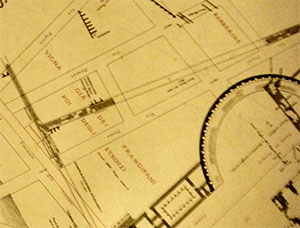

|
|
|
|
|
|
Hallo again to all. We firmly believe that the context of history is shaped by place and location. Likewise, we find that things we have assumed or taken for granted as part of the natural world are changed by human hands—or by time and happenstance. We recently discovered this in Rome, with the city's rather jarring decision to take the Forum Romanum from a public to ticketed venue. While wonderful for preservation, this has done very little to make the center of the city a usable pedestrian space.* In Rome, the past is visible in thick layers of previous eras and civilizations. In view of these ancient buildings, the parish building of St Paul's Within the Walls, the Episcopal Church USA's presence in Rome, seems like a positive newcomer, having only been constructed in the 1870s. Yet it too has been shaped by its place along the Via Nazionale at the heart of 'patriotic' Rome. The Church of England had held services in Papal Rome dating back to 1816 and despite a frosty response when asking for permission, managed by 1825 to have a small 'granary chapel' just outside the walls on the Porta del Popolo. This created a community of Anglicans in the city, and the location was more or less stable for the next several decades.† The seed that became St Paul's, however, was planted by the Rt Revd Alonzo Potter from the Diocese of Pennsylvania, who first held a Eucharist in 1859 at a private home near Piazza Trinità dei Monti (on top of the Spanish Steps, for those keeping score). This was certainly enough to ruffle Papal feathers, and it provoked a warning note from Cardinal Antonelli. For some decades thereafter, a small congregation named Grace Church grew up in Rome, jostled from location to location—usually US ambassadorial residences because the Holy See permitted 'untoward' religious practices only in embassies. Sites outside the city walls were also given a certain salutary neglect. All this changed with the 1870s and the rise of Italian nationalism. After the success of the Italian army in seizing the city of Rome from Papal control in September of 1873, the city was for the first time open to church buildings from outside the Roman Catholic tradition. The enthusiastic rector of Grace Church, Robert Jenkins Nevin, and the vestry wasted no time—twelve days to be precise—after the decisive battle of 20 September to begin the move to a location within the walls. So too did the English parish, All Saints', though somewhat more slowly because of an ongoing dispute with the city over the land where the original chapel was built. The bishop of Long Island, the Rt Revd A.N. Littlejohn, gave the sermon for the new building's consecration on the Feast of the Annunciation on 25 March 1875 and spoke to what a new sense of place meant for the congregation at the renamed St Paul's. After recalling Paul’s address to the saints in Rome, the bishop continued: Gathered here from a region far more remote than Achaia, and bearing with us many uses and traditions foreign to the religious tone and habit of this land, we yet accept and repeat, in all the broad and glowing charity in which they were originally uttered, the words of the apostolic salutation; recognizing in them, as we do, the voice of evangelic love which has risen through the ages all along from the various branches of the one body high above the strife of tongues and the clamors of heresy and schism.‡  We do not mean to imply the new building was welcomed with universal delight. The Italian press generally approved of St Paul's as a new expression of religious freedom, but the Vatican's Osservatore Romano condemned Anglicanism as 'nothing more than an infernal chaos of changes and contradictions'. And lest we seem one-sided, Fr Nevin was equally happy to call St Paul's a 'sprout of the Church thus planted in the midst of Papal heresy'. Relations today are thankfully a bit smoother, thanks to the work of Archbishop Ramsey and Paul VI, which bore fruit in 1966 with the foundation of the Anglican Centre in Rome.§ Throughout our communion all our parishes have a place, both literal and figurative, in their communities. For some, they are among the oldest civic institutions of their hamlet or city. For others, perhaps they are new and even made of materials we might scarcely associate with a parish building. During this Advent, we wonder what comes to mind for you when you think of those places where—to borrow Paul’s wording from Romans—you have been 'called to be saints'. See you next week. |
||
This web site is independent. It is not official in any way. Our editorial staff is private and unaffiliated. Please contact editor@anglicansonline.org about information on this page. ©2015 Society of Archbishop Justus. Please address all spam to press@anglicansonline.org |